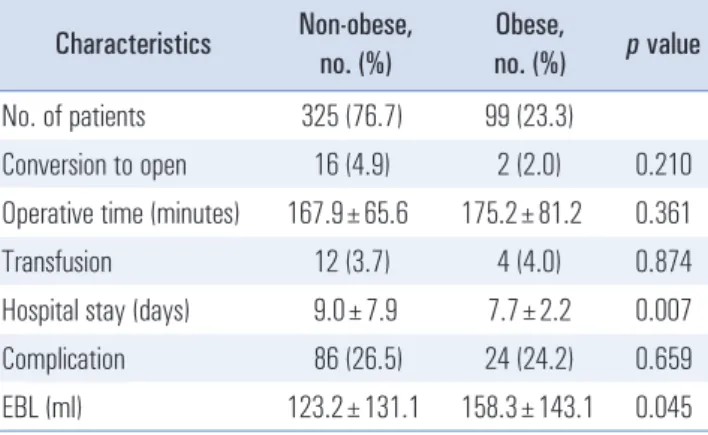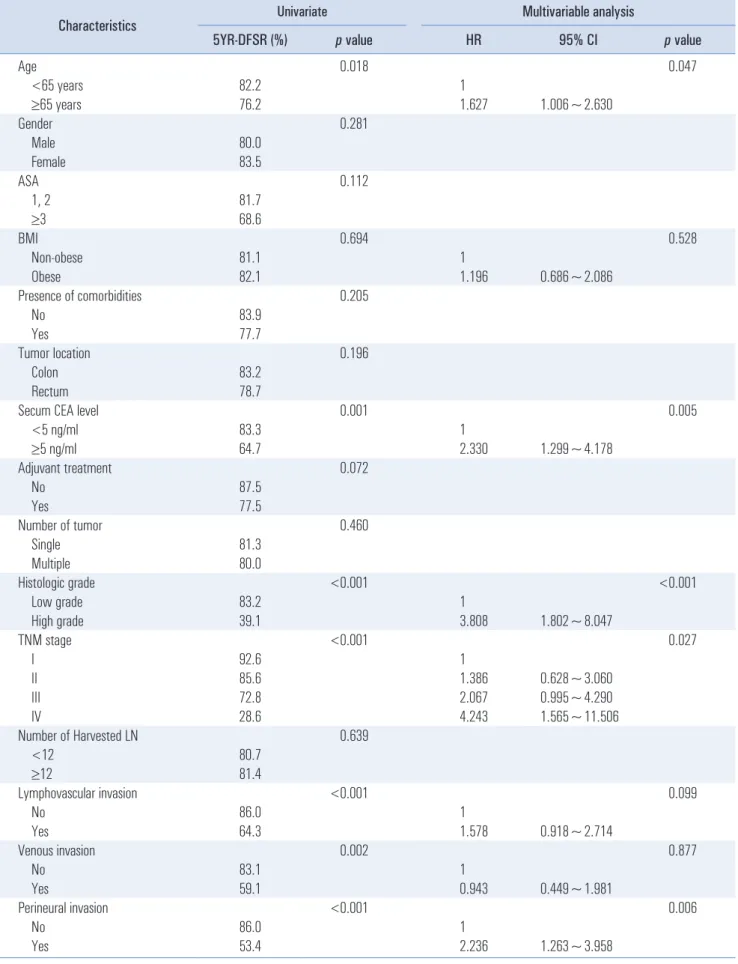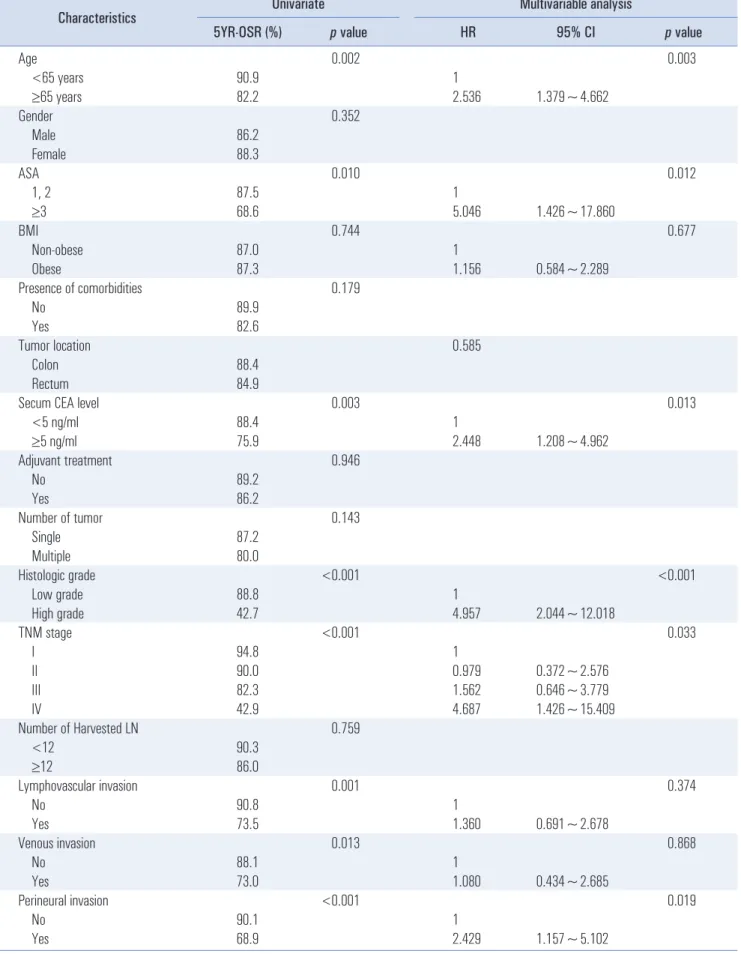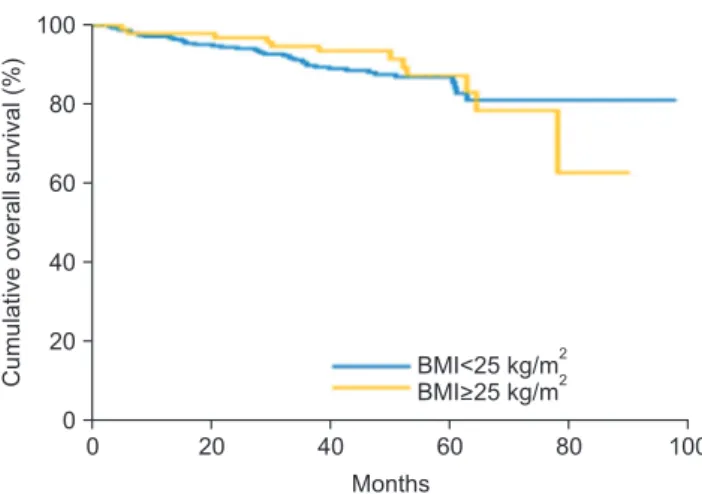Long-term Oncologic Outcomes of Obesity after Laparoscopic Surgery for Colorectal Cancer in Asian Patients
Jung Hak Kwak, M.D.
1, Ji Won Park, M.D.
1,2,3, Byung Kwan Park, M.D.
1, Eon Chul Han, M.D.
1, Jeong-Ki Kim, M.D.
1, Yoon-Hye Kwon, M.D.
1, Seung-Bum Ryoo, M.D.
1, Seung-Yong Jeong, M.D., Ph.D.
1,2,3, Kyu Joo Park, M.D., Ph.D.
1,31
Department of Surgery, Seoul National University College of Medicine,
2Cancer Research Institute, Seoul National University,
3Colorectal Cancer Center, Seoul National University Cancer Hospital, Seoul, Korea
Purpose:
The adverse effects of obesity on short-term surgical outcomes after laparoscopic colorectal surgery have been reported. However, the influence of obesity on long-term oncological outcomes after laparoscopic surgery in Asian patients has not been well understood. The aim of this study was to evaluate the effect of obesity on long-term oncologic outcomes in patients who underwent laparoscopic surgery for colorectal cancer.Methods:
Overall, 424 consecutive patients who underwent laparoscopic resection for colorectal cancer between January 2005 and July 2012 were included in this retrospective study. Patients were classified as non-obese (body mass index [BMI] <25.0 kg/m2) and obese (BMI ≥25.0 kg/m2) according to the categories proposed by the International Obesity Task Force. A survival analysis was performed using clinicopathologic characteristics, including obesity.Results:
Of the 424 patients, 325 (76.7%) were classified as non-obese and 99 (23.3%) as obese. The clinicopathologic characteristics of the obese and non-obese groups were similar, except that there were more underlying comorbidities, a lower frequency of smoking, and fewer tumors in rectum in the obese group. Results of the multivariate analysis showed that older age, elevated serum carcinoembryonic antigen, high-grade histology, advanced tumor stage, and perineural invasion were associated with poorer disease-free survival and overall survival. Obesity was not significantly associated with disease-free survival (hazard ratio [HR], 1.196; 95% confidence interval [CI], 0.686~2.086; p=0.528) or overall survival (HR, 1.156; 95% CI, 0.584~2.289; p=0.677).Conclusion:
Laparoscopic surgery for colorectal cancer seems to be safe and feasible for obese patients in terms of long-term oncologic outcomes.Keywords:
Obesity, Body mass index, Laparoscopic surgery, Colorectal cancerReceived August 22, 2016 Revised 1st October 19, 2016
2nd October 24, 2016 Accepted October 24, 2016
Corresponding author Ji Won Park
Colorectal Cancer Center, Seoul National University Cancer Hospital, 101 Daehak-ro, Yeongeon-dong, Jongno-gu, Seoul 03080, Korea Tel: +82-2-2072-2325 Fax: +82-2-766-3975 E-mail: sowisdom@gmail.com
This is an Open Access article distributed under the terms of the Creative Commons Attribution Non-Commercial License (http://
creativecommons.org/licenses/by-nc/4.0/) which permits unrestricted non-commercial use, distribution, and reproduction in any medium, provided the original work is properly cited.
Copyright © 2016 The Journal of Minimally Invasive Surgery. All rights reserved.
Journal of Minimally Invasive Surgery
J Minim Invasive Surg 2016;19(4):148-155
INtROduCtION
As obesity is a growing public health concern, numerous studies have been conducted to evaluate its effects on surgical outcomes. It has been suggested to be a risk factor that con- tributes to adverse surgical outcomes, including longer hospital
stays, longer operative times, higher conversion rates, and wound complications.
1-3Furthermore, obesity has been sug- gested to be a risk factor for wound infections and dehiscence, incisional hernias, stoma complications, obstructions, stric- tures, and anastomotic leaks.
4-6In Korea, the prevalence of obesity has increased from
26.9% (in 1998) to 32.0% (in 2011), according to the Korea National Health and Nutrition Examination Survey reports.
7Considering the increasing population of obese patients, there is a need for an approach that maintains the inherent benefits of minimally invasive surgery while improving outcomes for the obese after colorectal surgery.
4Regarding long-term on- cologic outcomes, several studies have revealed that the long- term outcomes of laparoscopic surgery for colorectal cancer in obese Western patients were similar to those in non-obese pa- tients.
6However, there are differences among ethnic popula- tions in obesity prevalence and body fat distributions. To date, little is known about the long-term outcomes of laparoscopic colorectal surgery with respect to obesity in Asians.
The aim of this study was to compare long-term outcomes between obese and non-obese Asian patients who underwent laparoscopic surgery for colorectal cancer.
MAtERIALS ANd MEthOdS
A total of 424 consecutive patients who underwent laparo- scopic resection for colorectal cancer between January 2005 and July 2012 at Seoul National University Hospital were included in this study. The medical records of these patients were reviewed retrospectively. The collected data included clinicopathologic variables and surgical outcomes. The clini- copathologic data included age, sex, body mass index (BMI), social history, history of abdominal surgeries, presence of comorbidities, American Society of Anesthesiologists (ASA) score, tumor location, and carcinoembryonic antigen (CEA) level; these were reviewed and compared with pathologic re- sults. Surgical outcomes included conversion rates, intraopera- tive events, operative time, length of the postoperative hospital stay, recurrence, overall survival, and disease-free survival.
This study was approved by the Institutional Review Board of the Seoul National University Hospital. Patients were divided into an obese group and a non-obese group on the basis of their BMI, in accordance with the categories proposed by the World Health Organization’s International Obesity Task Force (BMI <25 kg/m
2, non-obese; BMI ≥25 kg/m
2, obese).
7Laparoscopic colorectal surgery was performed as a stan- dardized procedure. Generally, five trocars were inserted, as follows: one 11-mm, two or three 5-mm, and one or two 12-mm trocars. An 11-mm umbilical trocar was used as the camera port using a 30
oangled scope. Ligation of the vessel and mobilization of the colon or rectum was performed lapa- roscopically. The specimen was extracted through an extended incision of the port in the lower left quadrant, umbilicus, or perineum. In the case of anterior resection or low anterior resection, anastomosis was performed extracorporeally with a circular stapler. In the case of right or left colectomy, anas-
tomosis was performed extracorporeally with two linear sta- plers.
All patients underwent a postoperative follow-up examina- tion every 3 or 6 months for the first 5 years and every year thereafter that comprised a physical examination, serum CEA measurements, chest radiographs, and abdominal and pelvic computed tomographic scanning. Colonofibroscopic examina- tions were performed every 1 or 2 years after surgery. Overall survival was defined as the time from surgery to death from any cause. Disease-free survival was defined as the time from surgery to a recurrence or death from any cause.
Data are presented as the number of patients and percent- ages or as means with standard deviations. Depending on the nature of the data, the chi-squared test, Fisher’s exact test, Student ’s t-test, or Mann-Whitney U-test was used for comparisons. A survival comparison was performed using the log-rank test of the Kaplan-Meier analysis. A multivari- able analysis of survival outcomes was performed with a Cox regression analysis. Statistical analysis was performed using SPSS software, version 19.0 (SPSS, Chicago, IL). A two-tailed p value <0.05 was the criterion for statistical significance.
RESuLtS
Among the 424 patients, 325 (76.7%) were classified as non-obese and 99 (23.3%) were classified as obese. The clinicopathological characteristics of patients according to their obesity statuses are presented in Table 1. There were no significant differences in clinicopathological characteristics between groups, with the exception of the presence of comor- bid diseases, smoking history, and location of the tumor. The obese group had more comorbid diseases, a lower frequency of smoking, and a lower prevalence of colonic tumors than did the non-obese group.
In terms of short-term outcomes, the conversion rates, op- erative times, transfusion rates, and complication rates were not significantly different between the obese and non-obese groups (Table 2). The length of hospitalization was shorter and the estimated blood loss was greater in the obese group than in the non-obese group.
The mean follow-up duration for patients was 46.3±19.1
(range: 0.6~97.7) months. Table 3 shows the results of the
analysis of the risk factors for disease-free survival. In the
univariate analysis, older age, elevated serum CEA level,
high-grade histology, advanced Tumor-Node-Metastasis
(TNM) stage, lymphovascular invasion, venous invasion, and
perineural invasion were associated with poor disease-free
survival. In the multivariable analysis, age, serum CEA level,
histologic grade, TNM stage, and perineural invasion were
independent significant risk factors for disease-free survival.
In the univariate analysis for overall survival, older age, high ASA score, elevated serum CEA level, high-grade histology, advanced TNM stage, lymphovascular invasion, venous inva- sion, and perineural invasion were associated with poor over-
all survival (Table 4). In the multivariable analysis, age, ASA, serum CEA level, histologic grade, TNM stage, and perineural invasion were independent significant risk factors for overall survival.
Importantly, in the univariate analysis, obesity was not sig- nificantly associated with disease-free survival (5-year dis- ease-free survival, 81.1% in the non-obese group versus 82.1%
in the obese group; p=0.694; Fig. 1) or with overall survival (5-year overall survival, 87.0% in the non-obese group versus 87.3% in the obese group; p=0.744; Fig. 2). In the multivari- able analysis, obesity was also not a significant risk factor for disease-free survival (hazard ratio, 1.196; 95% confidence in- terval, 0.686~2.086; p=0.528) or overall survival (hazard ratio, 1.156; 95% confidence interval, 0.584~2.289; P=0.677).
dISCuSSION
This study showed no significant differences between obese and non-obese patients in long-term survival after laparo- scopic colorectal cancer surgery. In terms of short-term out- comes, several studies have shown that obese patients have unfavorable surgical outcomes, such as longer operative times, increased conversion rates, increased postoperative complica- tion rates, and prolonged hospital stays.
1-3These unfavorable short-term outcomes may affect long-term outcomes for obese patients with colorectal cancer. However, some stud- ies in Western patients showed that long-term outcomes for obese patients were not different from those for non-obese patients.
3,5,6,8The present study in Asians showed similar re- sults. Thus, considering the results for long-term survival, laparoscopic colorectal surgery appears to be acceptable for obese Asians.
In Asia, lifestyle and dietary changes have resulted in in- creased rates of obesity, as more Western-style eating habits are now favored.
7During the last decade, the overall preva- Table 1. Clinicopathological characteristics of patients
Characteristics Non-obese, no. (%)
Obese,
no. (%) p value No. of patients 325 (76.7) 99 (23.3)
Age 0.338
<65 years 177 (54.5) 50 (50.5)
≥65 years 148 (45.5) 49 (49.5)
Gender 0.376
Male 200 (61.5) 56 (56.6)
Female 125 (38.5) 43 (43.4)
ASA ≥3 11 (3.4) 0 (0.0) 0.075
Presence of comorbid disease 128 (39.4) 56 (56.6) 0.003 Smoking history 45 (13.8) 5 (5.1) 0.018 Alcohol history 84 (25.8) 21 (21.2) 0.350
Location 0.042
Colon 186 (57.2) 68 (68.7)
Rectum 139 (42.8) 31 (31.3)
Elevated serum CEA (≥5 ng/ml) 37 (11.5) 11 (11.3) 0.967 Conversion to open 13 (4.0) 1 (1.0) 0.204 Number of tumor ≥2 6 (1.8) 2 (2.0) 0.911
Histologic grade 0.407
Low grade 312 (96.0) 93 (93.9)
High grade 13 (4.0) 6 (6.1)
TNM stage 0.346
I 116 (35.7) 26 (26.3)
II 90 (27.7) 29 (29.3)
III 109 (33.5) 40 (40.4)
IV 10 (3.1) 4 (4.0)
Harvested LN 19.5±9.9 18.9±9.7 0.647 Angiolymphatic invasion 65 (20.0) 24 (24.2) 0.364
Venous invasion 25 (7.7) 5 (5.1) 0.369
Perineural invasion 48 (14.8) 10 (10.1) 0.237 Adjuvant treatment 186 (57.2) 65 (65.7) 0.135 Follow-up duration (month) 45.7±19.5 48.4±17.4 0.205 ASA = American Society of Anesthesiologist; CEA = carcinoembryogenic antigen; LN = lymph node.
Table 2. Short-term outcomes in non-obese and obese groups Characteristics Non-obese,
no. (%)
Obese,
no. (%) p value No. of patients 325 (76.7) 99 (23.3)
Conversion to open 16 (4.9) 2 (2.0) 0.210 Operative time (minutes) 167.9±65.6 175.2±81.2 0.361
Transfusion 12 (3.7) 4 (4.0) 0.874
Hospital stay (days) 9.0±7.9 7.7±2.2 0.007
Complication 86 (26.5) 24 (24.2) 0.659
EBL (ml) 123.2±131.1 158.3±143.1 0.045
EBL = Estimated blood loss.
Table 3. Univariate and multivariable analysis for disease free survival
Characteristics Univariate Multivariable analysis
5YR-DFSR (%) p value HR 95% CI p value
Age 0.018 0.047
<65 years 82.2 1
≥65 years 76.2 1.627 1.006~2.630
Gender 0.281
Male 80.0
Female 83.5
ASA 0.112
1, 2 81.7
≥3 68.6
BMI 0.694 0.528
Non-obese 81.1 1
Obese 82.1 1.196 0.686~2.086
Presence of comorbidities 0.205
No 83.9
Yes 77.7
Tumor location 0.196
Colon 83.2
Rectum 78.7
Secum CEA level 0.001 0.005
<5 ng/ml 83.3 1
≥5 ng/ml 64.7 2.330 1.299~4.178
Adjuvant treatment 0.072
No 87.5
Yes 77.5
Number of tumor 0.460
Single 81.3
Multiple 80.0
Histologic grade <0.001 <0.001
Low grade 83.2 1
High grade 39.1 3.808 1.802~8.047
TNM stage <0.001 0.027
I 92.6 1
II 85.6 1.386 0.628~3.060
III 72.8 2.067 0.995~4.290
IV 28.6 4.243 1.565~11.506
Number of Harvested LN 0.639
<12 80.7
≥12 81.4
Lymphovascular invasion <0.001 0.099
No 86.0 1
Yes 64.3 1.578 0.918~2.714
Venous invasion 0.002 0.877
No 83.1 1
Yes 59.1 0.943 0.449~1.981
Perineural invasion <0.001 0.006
No 86.0 1
Yes 53.4 2.236 1.263~3.958
Table 4. Univariate and multivariable analysis for overall survival
Characteristics Univariate Multivariable analysis
5YR-OSR (%) p value HR 95% CI p value
Age 0.002 0.003
<65 years 90.9 1
≥65 years 82.2 2.536 1.379~4.662
Gender 0.352
Male 86.2
Female 88.3
ASA 0.010 0.012
1, 2 87.5 1
≥3 68.6 5.046 1.426~17.860
BMI 0.744 0.677
Non-obese 87.0 1
Obese 87.3 1.156 0.584~2.289
Presence of comorbidities 0.179
No 89.9
Yes 82.6
Tumor location 0.585
Colon 88.4
Rectum 84.9
Secum CEA level 0.003 0.013
<5 ng/ml 88.4 1
≥5 ng/ml 75.9 2.448 1.208~4.962
Adjuvant treatment 0.946
No 89.2
Yes 86.2
Number of tumor 0.143
Single 87.2
Multiple 80.0
Histologic grade <0.001 <0.001
Low grade 88.8 1
High grade 42.7 4.957 2.044~12.018
TNM stage <0.001 0.033
I 94.8 1
II 90.0 0.979 0.372~2.576
III 82.3 1.562 0.646~3.779
IV 42.9 4.687 1.426~15.409
Number of Harvested LN 0.759
<12 90.3
≥12 86.0
Lymphovascular invasion 0.001 0.374
No 90.8 1
Yes 73.5 1.360 0.691~2.678
Venous invasion 0.013 0.868
No 88.1 1
Yes 73.0 1.080 0.434~2.685
Perineural invasion <0.001 0.019
No 90.1 1
Yes 68.9 2.429 1.157~5.102
lence of obesity has also increased in Korea.
7With this trend, the penetration rates for laparoscopic resection for colorectal cancer have increased in Korea.
9Thus, a greater number of obese patients could undergo laparoscopic surgery for colorec- tal cancer. The evaluation of outcomes following laparoscopic colorectal cancer surgery in obese patients is therefore ur- gently required.
A recent systematic review and meta-analysis reported that approximately 20% of all malignancies were associated with obesity.
10Mortality associated with cancer in obese patients has increased to 24% with the worldwide increased preva- lence of obesity over time.
11Published data have shown that obesity and overweight are the cause of about 20% of deaths from cancer in women, while the rate is around 14% in men.
12The mechanisms underlying the association between obesity and cancer are not fully understood. A high BMI is known to be a risk factor that increases insulin resistance, hyperinsu- linemia, and free insulin-like growth factor (IGF)-I.
13Chronic hyperinsulinemia is associated with decreased concentrations of IGF-binding protein-1 and -2, which increase free IGF- I with concomitant changes in the cellular environment that favor tumor formation.
14,15Likewise, obesity itself may affect outcomes following cancer. In addition, tumor resection can be difficult in obese patients. Obstacles to performing laparo- scopic surgery in obese patients include difficulties in obtain- ing an adequate operative field and difficulties in the intra- abdominal maneuvering of instruments in a restricted working area.
2,16These difficulties may also affect oncologic outcomes following colorectal cancer. However, this study showed no adverse effect of obesity on survival following laparoscopic colorectal cancer surgery.
BMI has been broadly used as an index to show a patient ’s degree of obesity.
17We used the cut-off value (25 kg/m
2) sug- gested by the International Obesity Task Force.
7The cut-
off value in Asian countries is different from that in Western countries (30 kg/m
2). This study included only a small number of patients with morbid obesity (30 kg/m
2) according to the Asian criteria. The outcomes of morbidly obese patients should be evaluated in a larger multi-center study that includes more morbidly obese patients. Another index for obesity is visceral adiposity. Visceral adiposity is assessed based on the amount of fat evident on abdominal computed tomography or based on waist circumference. Visceral adiposity may more accurately indicate the status of obesity than BMI can. Future studies us- ing visceral obesity are required.
Multiple studies have shown an association between obesity and colorectal cancer. Obesity has been shown to increase the risk of developing colorectal cancer almost 2-fold, with insulin and insulin-like growth factor (IGF) postulated as important mediators in the oncogenic process. However, re- cent reports suggest that there is insufficient evidence of a strong association between obesity and survival in colorectal cancer.
18-20Therefore, it is unclear whether long-term surgical outcomes are adversely affected by obesity, because there have been many conflicting reports.
Recently, as obesity has become an important issue with respect to outcomes following colorectal cancer surgery, sev- eral studies have reported the effects of obesity on surgical outcomes. Obesity has been associated with poor short-term outcomes following laparoscopic colorectal surgery, including longer hospital stays, longer operative times, higher conver- sion rates, and wound complications. However, obesity was not associated with adverse short-term outcomes in this study, except with respect to estimated blood loss. This discrepancy may be related to differences in the definition of obesity used in the studies.
In a previous study, a greater number of metastatic regional lymph nodes was found in obese patients than in patients
0 20 40 60 80
100
80
60
40
20
100
Cumulativedisease-freesurvival(%)
Months 0
BMI<25 kg/m2 BMI>25 kg/m2
Fig. 1. Disease-free survival graph according to obesity ( p value=0.694).
0 20 40 60 80
100
80
60
40
20
100
Cumulativeoverallsurvival(%)
Months 0
BMI<25 kg/m2 BMI>25 kg/m2
Fig. 2. Overall survival graph according to obesity (p value=0.744).
with normal weight. These findings suggest that obesity is an adverse prognostic variable in colorectal cancer surgery.
19,21However, several studies have shown that there were no sig- nificant differences in survival between obese and non-obese Western patients.
5,22To our knowledge, few studies have ex- amined long-term surgical outcomes following laparoscopic colorectal cancer in Asian patients. The results of this study showed no significant differences in disease-free and over- all survival between obese and non-obese patients in Asian countries.
In this study, obese patients had more comorbidities than non-obese patients did. This heterogeneity could be a con- founder. To evaluate the main effects of obesity on survival, we performed a multivariable analysis that included comor- bidities. After adjusting for other significant factors, includ- ing comorbidities, obesity was not a significant prognostic factor (disease-free survival: HR, 0.742; 95% CI, 0.422~1.306;
p=0.301; overall survival: HR, 0.792; 95% CI, 0.398~1.575;
p=0.506). In the present study, long-term outcomes did not differ between obese and non-obese patients after adjustment for comorbidities. Limitations of the study include its retro- spective design and that it included data only from a single institution. Large multicenter studies will provide more defi- nite conclusions. This study may be useful by providing base- line data for further studies.
If information regarding patient obesity is obtained before surgery, it may be useful to develop a strategy to use laparo- scopic colorectal cancer surgery. With sufficient experience, laparoscopic colorectal cancer surgery in obese patients may be feasible in terms of long-term survival. Colorectal surgeons should be aware of obesity-related challenges in these pa- tients.
In conclusion, laparoscopic surgery for colorectal cancer in obese Asian patients seems to be safe and feasible based on long-term oncologic outcomes.
ACkNOwLEdgMENtS
This research was partly supported by a grant from the Na- tional R&D Program for Cancer Control, Ministry for Health and Welfare, Republic of Korea (grant number 10515608) and partly supported by Basic Science Research Program through the National Research Foundation of Korea (NRF) funded by the Ministry of Science, ICT & Future Planning, Republic of Korea (grant number 2015008884). The authors thank Amanda for the English editing of the manuscript.
REFERENCES
1) Mustain WC, Davenport DL, Hourigan JS, Vargas HD. Obesity
and laparoscopic colectomy: outcomes from the ACS-NSQIP da- tabase. Dis Colon Rectum 2012;55:429-435.
2) Park JW, Lim SW, Choi HS, Jeong SY, Oh JH, Lim SB. The im- pact of obesity on outcomes of laparoscopic surgery for colorectal cancer in Asians. Surg Endosc 2010;24:1679-1685.
3) Senagore AJ, Delaney CP, Madboulay K, Brady KM, Fazio VW.
Laparoscopic colectomy in obese and nonobese patients. J Gastro- intest Surg 2003;7:558-561.
4) Keller DS, Madhoun N, Flores-Gonzalez JR, Ibarra S, Tahilra- mani R, Haas EM. Effect of BMI on Short-Term Outcomes with Robotic-Assisted Laparoscopic Surgery: a Case-Matched Study. J Gastrointest Surg 2016;20:488-493.
5) Makino T, Trencheva K, Shukla PJ, et al. The influence of obe- sity on short- and long-term outcomes after laparoscopic surgery for colon cancer: a case-matched study of 152 patients. Surgery 2014;156:661-668.
6) Vignali A, De Nardi P, Ghirardelli L, Di Palo S, Staudacher C.
Short and long-term outcomes of laparoscopic colectomy in obese patients. World J Gastroenterol 2013;19:7405-7411.
7) Kim CS, Ko SH, Kwon HS, et al. Prevalence, awareness, and management of obesity in Korea: data from the Korea national health and nutrition examination survey (1998-2011). Diabetes Metab J 2014;38:35-43.
8) Pikarsky AJ, Saida Y, Yamaguchi T, et al. Is obesity a high- risk factor for laparoscopic colorectal surgery? Surg Endosc 2002;16:855-858.
9) Park SJ, Lee KY, Lee SH. Laparoscopic Surgery for Colorectal Cancer in Korea: Nationwide Data from 2008~2013. J Minim In- vasive Surg 2015;18:39-43.
10) De Pergola G, Silvestris F. Obesity as a major risk factor for can- cer. J Obes 2013;2013:291546.
11) Jaggers JR, Sui X, Hooker SP, et al. Metabolic syndrome and risk of cancer mortality in men. Eur J Cancer 2009;45:1831-1838.
12) Calle EE, Rodriguez C, Walker-Thurmond K, Thun MJ. Over- weight, obesity, and mortality from cancer in a prospectively stud- ied cohort of U.S. adults. N Engl J Med 2003;348:1625-1638.
13) Giovannucci E. Insulin, insulin-like growth factors and colon cancer: a review of the evidence. J Nutr 2001;131:3109s-3120s.
14) Renehan AG, Frystyk J, Flyvbjerg A. Obesity and cancer risk:
the role of the insulin-IGF axis. Trends Endocrinol Metab 2006;17:328-336.
15) Renehan AG, Tyson M, Egger M, Heller RF, Zwahlen M.
Body-mass index and incidence of cancer: a systematic review and meta-analysis of prospective observational studies. Lancet 2008;371:569-578.
16) Lascano CA, Kaidar-Person O, Szomstein S, Rosenthal R, Wexner SD. Challenges of laparoscopic colectomy in the obese patient: a review. Am J Surg 2006;192:357-365.
17) WHO Expert Consultation. Appropriate body-mass index for Asian populations and its implications for policy and intervention
strategies. Lancet 2004;363:157-163.
18) Parkin E, O’Reilly DA, Sherlock DJ, Manoharan P, Renehan AG.
Excess adiposity and survival in patients with colorectal cancer: a systematic review. Obes Rev 2014;15:434-451.
19) Sinicrope FA, Foster NR, Sargent DJ, O’Connell MJ, Rankin C.
Obesity is an independent prognostic variable in colon cancer sur- vivors. Clin Cancer Res 2010;16:1884-1893.
20) Moore LL, Bradlee ML, Singer MR, et al. BMI and waist circum-
ference as predictors of lifetime colon cancer risk in Framingham Study adults. Int J Obes Relat Metab Disord 2004;28:559-567.
21) Greene FL, Stewart AK, Norton HJ. A new TNM staging strategy for node-positive (stage III) colon cancer: an analysis of 50,042 patients. Ann Surg 2002;236:416-421; discussion 421.
22) Singh A, Muthukumarasamy G, Pawa N, Riaz AA, Hendricks JB, Motson RW. Laparoscopic colorectal cancer surgery in obese pa- tients. Colorectal Dis 2011;13:878-883.



